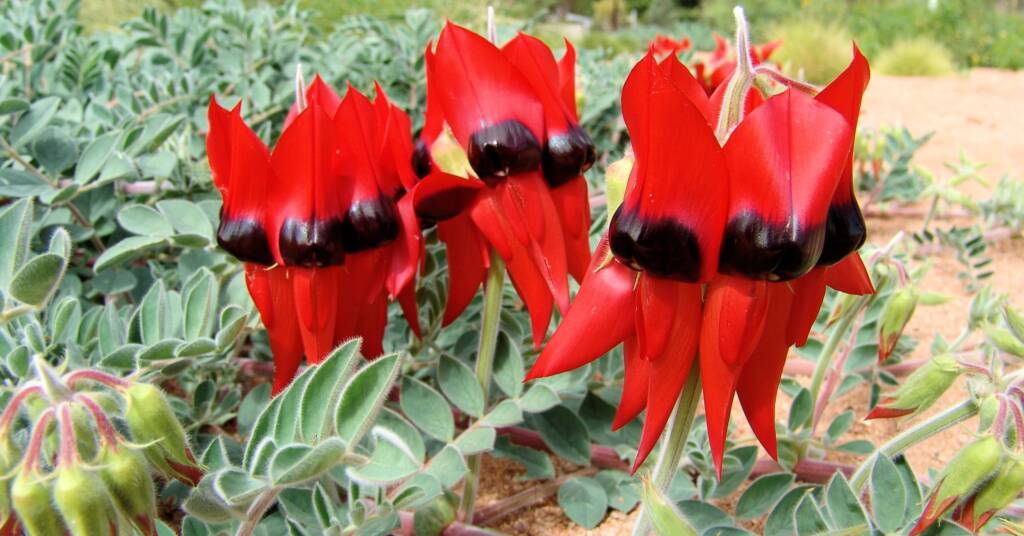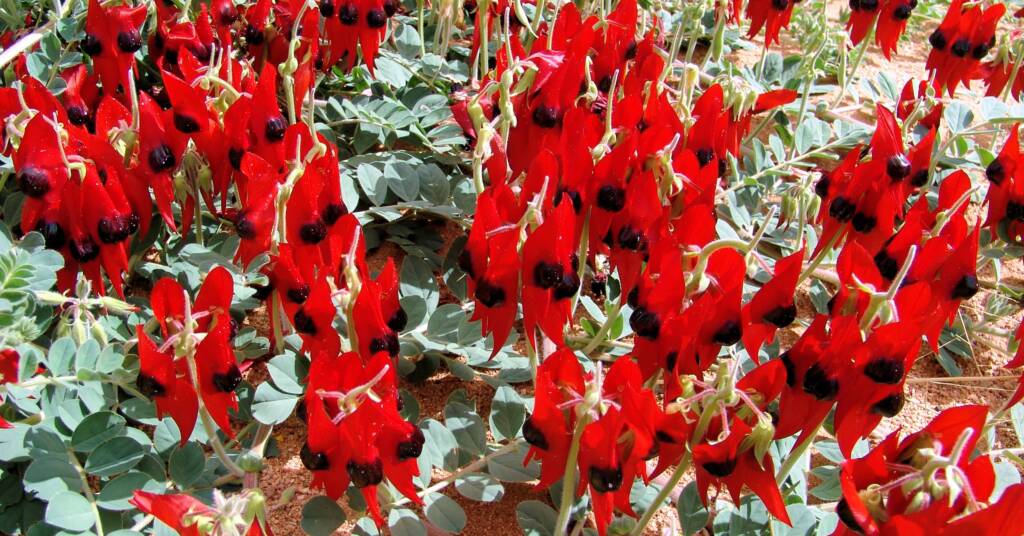Australian Aboriginal Tales of the Dreaming…
| WARNING: Aboriginal and Torres Strait Islander people are warned that this website contain images, voices and names of people who have passed away. |
The Sturt’s Desert Pea has a number of variation on the dreaming story, including the following…
An archetypal story of doomed love, a young couple elope against the wishes of their kin (she is already betrothed to another), leaving the woman’s tribe to live with the man’s people far away. The woman eventually bears a child, a son whom the couple love dearly. The woman has a gift for channeling the songs of the spirits, and would often sing their words. One day they warn of impending danger and also of immortality for their son. The woman warns her husband but he is too complacent, disregarding the message as foolishness. Shortly afterwards, in the dark of night, the woman’s former betrothed sneaks upon them and he and his men slaughter them all – man, woman and child. Their blood stains the soil and the boy’s body is transformed into the first Sturt’s Desert Pea – his immortal life is begun. A season later, the man returns to gloat over the bones and finds instead the flowers growing abundantly. The Great Spirit, in retribution, sends down a bolt of lightning, killing him instantly and transforming his body into a rock, which is shattered into millions of pieces. The tears of the grief-stricken song spirits dry and turn to salt, causing the salinity of the lakes in that region.
Mountford, Charles P. “The Dreamtime.” Reed, A.W. “Aboriginal Myths, Legends & Fables.”

A long time ago, there were two young people from different tribes that were deeply in love, a young man Borola and a girl Purlimil.
Purlimil was however, promised to Trlta from her tribe. He was a Wirrigan or clever old fella, who possessed much magic.
The love between the young people was strong and they would secretly meet at night, but always in fear of discovery. They knew they would have to go far away, so one night under cover of darkness and whilst everyone was sleeping, they left to go away.
They travelled far away, arriving exhausted at the lake campsite of Borola’s tribe.
After some years had passed and there was no retaliation, the couple relaxed, but Trlta never forgot that Purlimil was his promised bride.
Then one day along with armed warriors, Trlta set off across the desert and headed toward the lake in search of the young couple.
It was late at night, when they came across the campsite of Borola’s people and everyone was asleep. Creeping through the darkness, they entered the campsite with their spears and killed everyone, including Borola and Purlimil. The blood of the slaughtered ran across the plains, staining the desert sands red.
The Sky Spirits looking down, wept tears of salt at the death of these innocent people.
The following year, Trlta returned to the scene of his crime, and to his surprise he found the lake was full of salt (which had come from the tears of the Sky Spirits) and the land around it was covered by masses of red flowers with black eyes.
Suddenly the heavens opened up and like a bolt of lightning, a spear struck Trlta to the ground. As he lay dying the Sky Spirits told Trlta, you are being punished for the great wrong you have done at this place murdering innocent people.
After his death, the body of Trlta was transformed into a large rock. After some time, the rock shattered into millions of pieces where they lay scattered around Lake Eyre, to this day.
Source: Australian Aboriginal Tales from the Dreaming, Gadi Mirrabooka, Author; Helen F. McKay, Editor

Check out our Flora – Sturt’s Desert Pea (Swainsona formosa)

Aboriginal DreamingBrolga Dreaming Flowers of Blood How the Perentie and Goanna got their Colours Gnoilya (Wild Dog) Tmerga
Aboriginal Art & CultureAboriginal Art Centres Aboriginal Art Centres Aboriginal Dreaming Aboriginal Symbols
